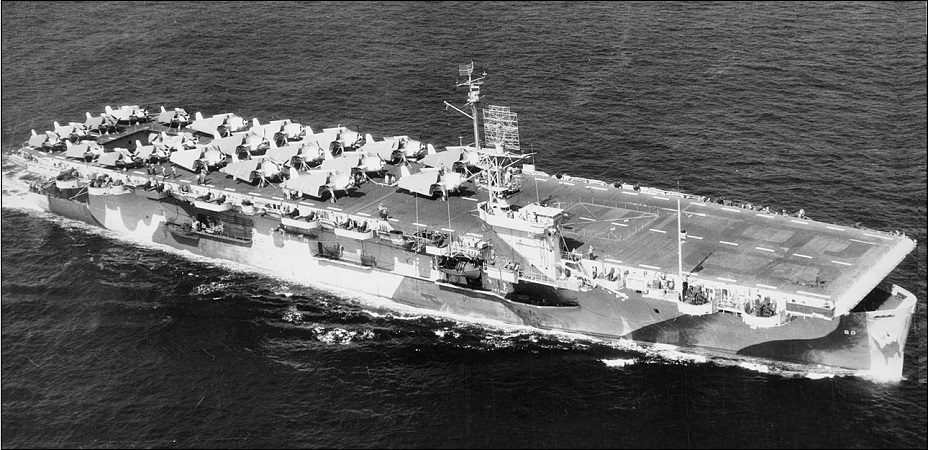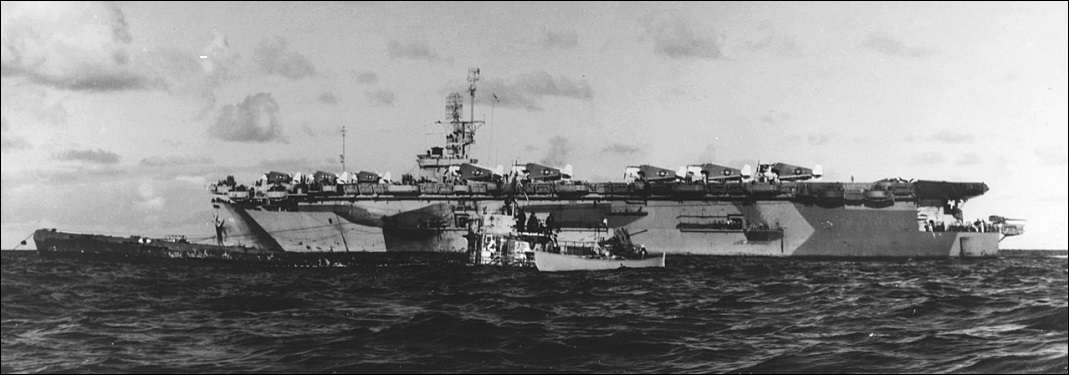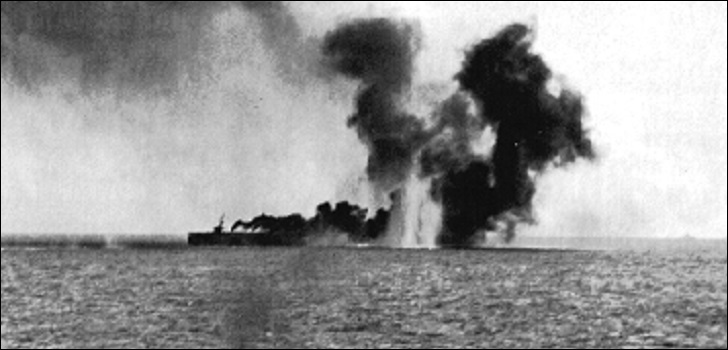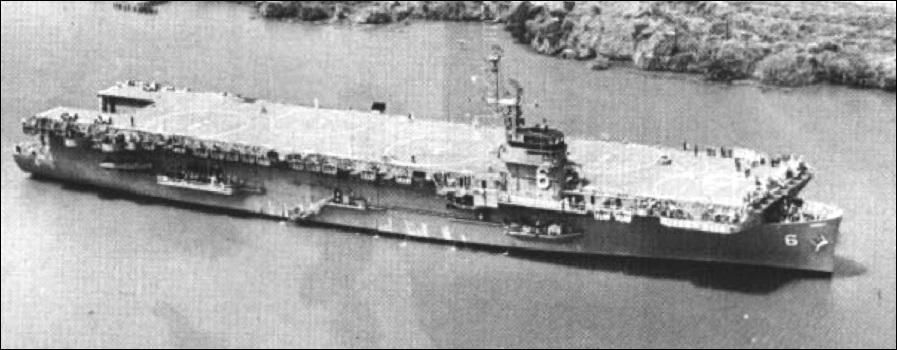The following abbreviations are
used in this article: AA (antiaircraft), DD (destroyer), DE
(destroyer escort), DP (dual-purpose surface/AA gun), RN
(Royal Navy), USN (United States Navy). The F4F Wildcat
fighter was designed and originally produced by Grumman.
When that company switched to production of the follow-on
F6F Hellcat, responsibility for Wildcat production passed to
General Motors, and the Wildcats it produced were designated
FM. Similarly, when TBF Avenger torpedo bomber production
passed from Grumman to General Motors, the aircraft’s
designation became TBM. To avoid confusion, the designations
F4F and TBF are used throughout this article. The air group
operating from escort carriers was designated as a Composite
Squadron (VC), e.g. VC-10, assigned to USS Gambier Bay
(CVE 73). The USN
initially classified the jeep carriers as auxiliary
aircraft escort vessels (AVG). In early 1942 they were
reclassified as auxiliary aircraft carriers (ACV), and in
mid-1943 they became escort aircraft carriers (CVE). Again
to avoid confusion, the CVE classification is used
throughout this article.
● ● ●
During World War II, the US Navy
operated three categories of aircraft carriers: fleet
carriers (CV), light fleet carriers (CVL) and escort
aircraft carriers (CVE). The CVs and CVLs were strike
carriers designed for offensive operations. CVEs—the jeep
carriers as they were nicknamed—were either conversions of
civilian merchant ships or new construction based on
mercantile designs. As such they were significantly smaller
and slower than the CVs and CVLs.
The CVE’s origins may be traced to
World War I, when various merchant vessels were taken into
naval service for conversion to seaplane carriers. The
primary user was Britain’s Royal Navy, which commissioned
around a dozen such ships. A typical example was HMS
Empress, a
former cross-Channel steamer that could carry six seaplanes.
Most of these ships had no flight deck, the aircraft being
handled by cranes. They proved useful, however, and in the
1930s the Admiralty had plans to requisition five passenger
liners for conversion into auxiliary carriers for service as
convoy escorts, training ships and aircraft transports.
Nothing was done, however, since at the time the Royal Navy
possessed insufficient aircraft to provide even its fleet
carriers with full air groups.
Only with the onset of World War II
did Britain embark upon an auxiliary carrier program. A
number of merchant ships were requisitioned and converted,
the first of which was HMS Audacity, formerly the
German cargo liner Hannover, which had been captured
in March 1940. Audacity had a full-length flight deck
but no island, catapult or internal hanger, her eight
aircraft being carried on deck. Despite these unsatisfactory
features she operated successfully in the Atlantic,
providing effective air cover for convoys between the UK and
Gibraltar, until she was torpedoed and sunk by a U-boat in
December 1941.
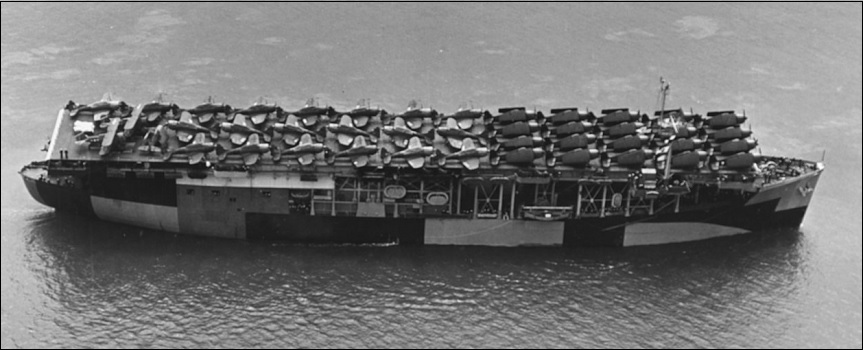
The first of the
jeep carriers, USS Long Island (CVE-1),
seen here serving as an aircraft transport in
1944. On deck are 21
F6F Hellcat
fighters,
20 SBD Dauntless dive
bombers and two Grumman J2F Duck
utility floatplanes.
(Wikimedia Commons)
At first the CVE concept was looked
upon with disfavor by the USN, which preferred large fleet
carriers. But the need for additional carriers in 1942 led
first to the development of the so-called light fleet
carriers built on cruiser hulls and then to a series of
small auxiliary carriers, the first of which was USS Long
Island, formerly the cargo ship Mormacmail.
She was acquired by the Navy and converted in 1941. The
initial intention was to employ her as an aircraft
transport. After completion, however, she received an air
group and embarked upon a series of trials to test the
concept of the escort aircraft carrier. Long
Island was soon joined
by a sister ship, USS Charger,
which had originally been earmarked for transfer to the RN.
These two ships were the prototypes for the mass-produced
“Bogue” class CVEs, 45 of which were built from 1942 to
1944.
The first 22 units of the “Bogue” class were conversions of
completed or near-complete US Maritime Commission Type C-3
cargo ships; the remaining 23 were built as carriers from
the keel up. Long Island
and Charger
were diesel propelled with a maximum speed of about sixteen
knots, which was considered too slow. The “Bogues,”
therefore, were given steam turbine propulsion, raising
their maximum speed to 18-19 knots. Their full-load
displacement was 14,200 tons, overall length was 495 feet,
waterline beam was 65 feet, and flight deck length was 440
feet. The internal hanger was served by two flight deck
elevators and the ships were fitted with a single aircraft
catapult. Experience with the flush-decked Long
Island showed the need
for an island bridge and flight control position. Thus
Charger was
completed with a small starboard-side island and a similar
one was adopted for the “Bogues”
As completed they were armed with a pair of 5in/51 guns plus
ten single 20mm guns as light AA.
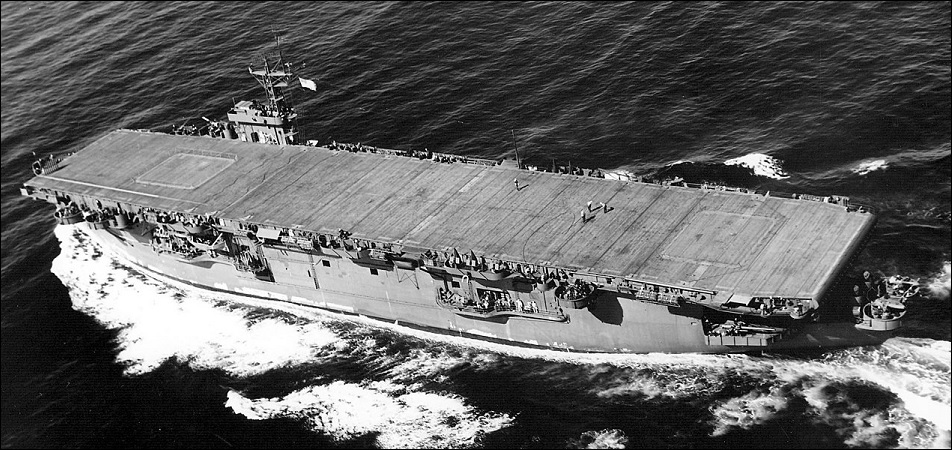
USS Breton
(CVE-23) of the "Bogue" class, shortly after
commissioning on 9 April 1943. Visible on her flight
deck are the two elevators serving the internal
aircraft hangers. Also visible under the flight deck
aft is one of the two 5in/51 guns with which the "Bogues"
were originally armed. They could not be used
against aircraft and were replaced by a single
5in/38 DP gun right aft. (National Museum of Naval
Aviation)
Of the 45
“Bouge” class CVEs completed, 34 were transferred to the RN
via Lend-lease, leaving only eleven in USN service. These
were joined by the follow-on “Casablanca” class, fifty of
which were completed and commissioned from late 1942 to
mid-1944—the largest class of aircraft carriers ever
constructed. The “Casablancas” were designed from the keel
up as carriers, though built to mercantile production
standards. They were smaller than the “Bouges” and due to
manufacturing bottlenecks received reciprocating engines instead of steam turbines, so that
their range was less. As completed their armament consisted
of one 5in/38 DP, four twin 40mm AA and twelve single 20mm
AA. By 1945, however, both classes had a pair of 5in/38s,
eight to ten twin 40mm and up to 27 20mm.
To meet the pressing need for
aircraft carriers in 1942, the USN also decided to convert
four Type T-3 naval oilers into escort carriers. These ships
constituted the “Sangamon” class and they were considerably
larger than the “Bouges”
and “Casablancas,”
with a much longer flight deck a more powerful catapult and,
thanks to their oil tanker origins, an exceptionally wide
radius of action. The Sangamons” successfully filled
the gap in the Pacific until sufficient CVs and CVLs became
available, and they were the prototypes for the final
wartime CVEs, the “Commencement Bay” class. These ships were
based on the T-3 tanker hull but were built as carriers
from the keel up. Thirty-three were ordered but only nineteen were
eventually commissioned in the USN, some postwar. The rest
were canceled. Those commissioned during the war (late
1944-1945) saw little service before VJ-Day.

USS
Chenango (CVE 28) of the "Sangamon"
class. She, her three sisters and the
follow-on "Commencement Bay" class were the
largest and most capable of the CVEs.
(Naval Heritage & History Command)
In US Navy service, the jeep
carriers carried between nineteen and 33 fighters and
bombers. In late 1943-early 1944 the “Bogue” and
“Casablanca” classes serving in the Atlantic shipped an air
group consisting of nine F4F Wildcat fighters and twelve TBF
Avenger torpedo bombers; if operating in the Pacific their
air group consisted of eighteen F4Fs and twelve TBFs. For
the larger “Sangamon” class, the air group consisted of 24
F4Fs and nine TBFs. Later in the war the four “Sangamons”
and the follow-on “Commencement Bay” class had air groups
consisting of eighteen F6F Hellcat fighters and twelve TBFs.
Thanks to their larger hangers and longer flight decks, they
were the only CVEs capable of operating the F6F and the
Vought F4U
Corsair, both of which were
considerably larger than the F4F. To speed
flight deck operations, the “Sangamons” were refitted with a
second catapult and the “Commencement Bays” were completed
with two catapults.

An FM-2 Wildcat (General Motors-produced
version of the F4F-4) of VC-24, the USS Block Island
(CVE-21) air group.
(Naval Heritage & History Command)
Though it was obsolescent as a
front-line fighter by 1943, the Wildcat acquired an extended
lease on life aboard the jeep carriers. The F4F-4 model with
folding wings economized on space in the hanger and could
take off from the CVE’s relatively short flight deck without
catapult assist. Thus the Wildcat remained in production
right to the end of the war. Some 8,000 were produced,
nearly 1,000 of which were supplied to Britain’s Royal Navy.
The Avenger, which was the largest single-engine aircraft
operated by the Navy during the war, required catapult
assist for takeoff. Its enclosed weapons bay could
accommodate bombs or depth charges in place of a torpedo,
and the TBF could also carry air-to-surface rockets
underwing. Aboard CVEs in the Atlantic, the Avenger served
primarily as an antisubmarine aircraft, while in the Pacific
it was also employed aboard CVEs as a light bomber and
ground attack aircraft.
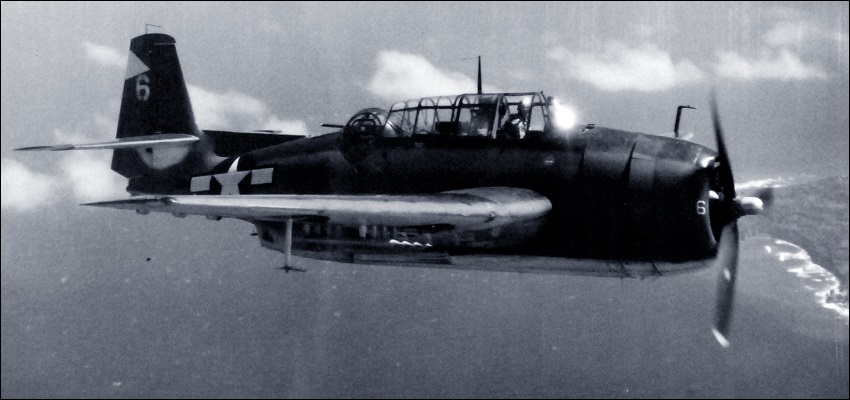
A TBM-3 Avenger (General Motors-produced
version of the TBF), carrying air-to-surface rockets
underwing. (NavSource Online)
The introduction of the CVE
revolutionized antisubmarine warfare: For the first time,
convoys could be provided with on-the-spot air support. In
combination with destroyer escorts, they also formed
independent hunter-killer groups. These consisted of a CVE
and several escorts, initially older fleet destroyers like
the four-piper
escort conversions, later
destroyer escorts.
Hunter-killer groups served as convoy escorts and also
operated independently, locating and destroying U-boats on
passage to and from the Atlantic. This roving hunter-killer concept
proved most successful. The ever-present possibility of air
attack compelled the U-boats to remain submerged during
daylight hours, greatly impeding their operations. If caught
on the surface by aircraft from a CVE, they were likely to
be damaged or sunk in short order. The hunter-killer group
formed around USS Bouge
(CVE-9), for example, sank
or damaged fifteen German and Japanese submarines between
April 1943 and April 1945. On 4 June 1944, the group formed
around USS
Guadalcanal (CVE-60)
captured U-505.
The U-boat was first damaged by depth charges from the
destroyer escort USS
Chatelain
(DE-149) and when it surfaced boarding parties from the
escort and the carrier took control of her before she could
be scuttled. U-505
was taken in tow by
Guadalcanal and
brought into port at Bermuda. She was the first enemy vessel
captured on the high seas by the USN since 1815 and is now
on display at the Museum of Science and Industry, Chicago,
Illinois.
